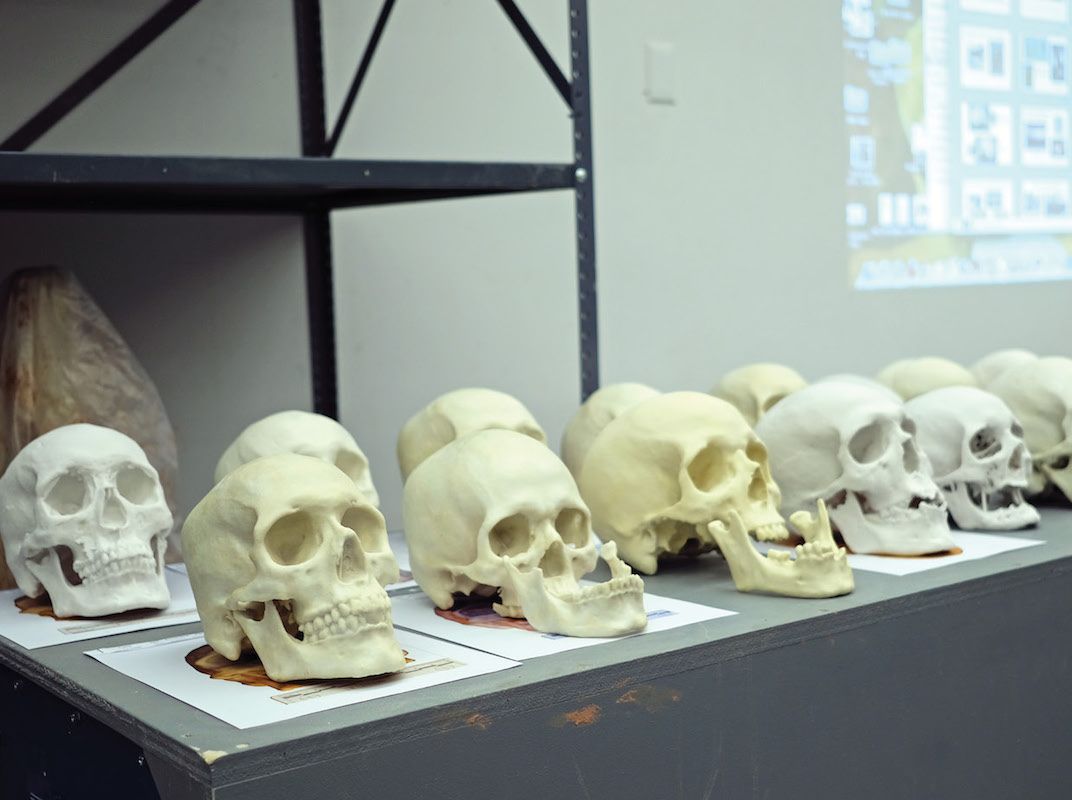To Help Identify Migrants Who Died Along Border, Art Class Reconstructs Their Faces
When DNA analysis and dental exams aren’t possible, facial reconstruction is a last-resort to identifying remains
/https://tf-cmsv2-smithsonianmag-media.s3.amazonaws.com/filer/10/7d/107d0e26-39be-48cb-83ea-5c467eb74ed8/forensic18-photo-2.jpg)
Every year, hundreds of migrants traveling across the Mexican border die while attempting to cross into the United States. The conditions of Arizona, Texas and New Mexico, and the risky nature of the journey, can cause the individuals to die by heat stroke, hyperthermia due to exposure to the elements and dehydration.
Their bodies are not easy to identify. Though medical examiners try DNA and dental comparisons, many migrants go unidentified.
Recently, however, students at the New York Academy of Art helped a Tuscon, Arizona, medical examiner’s office take a step toward naming some of the nameless by reconstructing the faces of eight migrants.
As Patricia Leigh Brown reports for The New York Times, the workshop, taught by forensic artist Joe Mullins of the National Center for Missing and Exploited Children, is part of a pilot program recreating faces from the remains of the individuals who were discovered in the desert.
According to Brown, CT-scans of migrants’ skulls were used to create 3D-printed replicas. The New York Academy of Art students, who are trained in anatomy, used whatever context they might know from the Pima County medical examiner, like an estimate of the migrant’s age, to rebuild the person’s muscles and soft tissue layer with clay. Tissue depths, which the students marked using cut plastic straws placed on the clay, were based on researchers’ guesses for age, gender and cultural background.
The reconstructions have marbles for eyes and a marker to dot the pupils.
The project is part of the growing field of forensic facial reconstruction, which combines science, art and anthropology to help solve crimes or mass disasters.
According to the press release, the New York Academy of Art course was created in 2015 in a partnership with the New York City Office of the Medical Examiner. In its first year, student created 11 busts from New York City skeletal remains, resulting in one positive identification. In 2016, the program expanded to include skulls from cold cases around the country.
Facial reconstruction as a means of identifying lost persons is not a new art. In fact, the first scientific reconstructions date back to 1895, when German anatomist Wilhem His modeled a bust onto the plaster cast of the skull of Johann Sebastian Bach. Soon after, in 1916, an unidentified skeleton found in a Brooklyn residence was confirmed as the remains of a man named Domenico La Rosa after an artist, using a medium called "plastelina"—where colored plasticine was molded over the bones of the face—allowed the sister of the missing person to identify La Rosa’s remains.
The technique has come a long way since then, with today’s reconstructions achieving incredibly lifelike results. While reconstructions are often employed by forensic specialists, they’re also used by archaeologists hoping to better understand early humans. This January, for instance, the reconstructed face of an 18-year-old woman who lived some 9,000 years ago was unveiled at Greece's Acropolis Museum.
In forensic use, new 3D technology has minimized degrees of errors, researchers have found. When DNA and dental exams fail and a face can’t be identified due decay, that’s when facial reconstruction steps in.
While facial reconstruction is a last-resort for identifying unknown persons, it’s nevertheless an important resource. According to the press release, there are currently thousands of skeletal remains waiting identification.
As it happens, two of the eight migrants student reconstructed have already been identified independent of the project thanks to DNA tests and family members. For the other six reconstructions created by the class, they just might provide the recognition someone needs to identify a body and bring some closure to those the individual left behind.
View all eight recreations at the website of the National Institute of Justice’s National Missing and Unidentified Persons System, NamUs.
